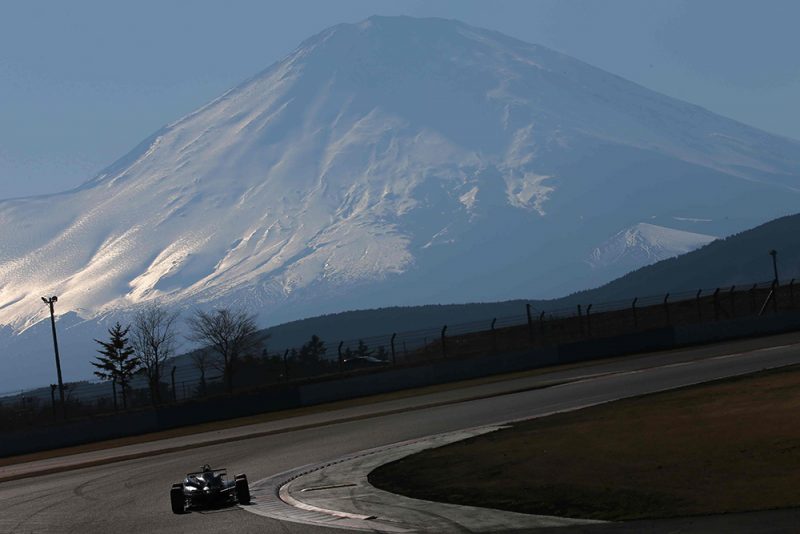
Photo: Red Bull Content Pool / Taku Nagami
Although 34 of the 46 Super Formula titles have been won by home-grown Japanese talents – including each of the last seven – there has always been a global touch to the championship.
Since 2016 the global stature of Super Formula (SF) has grown, with both the McLaren and Red Bull Formula 1 teams using it as a finishing school for its juniors. Over a third of this year’s grid comes from abroad, and with considerable upheaval taking place in Europe?s junior single-seater ladder, Japan has emerged as a evermore suitable alternative to becoming a professional driver.
The key to Japan?s appeal is that, just like IndyCar, there?s the opportunity to be a paid single-seater driver outside of F1. Audi Le Mans stars Andre Lotterer, Loic Duval and Benoit Treluyer took advantage of this in the 2000s, each adding a title to their name. More recently Kiwi talent Nick Cassidy, who played second fiddle for Lance Stroll in European Formula 3, has made himself a crucial part of Toyota?s domestic programmes.
This year Red Bull is bringing two big names to Japan: one who?s aching for a F1 drive, and another who could relaunch his career.
Dan Ticktum?s story is oft told, and the 19-year-old Briton is not a stranger to SF having contested two rounds in 2018. He scored zero points, but could take solace in being the best of the cameoing drivers.
As Red Bull junior boss Dr Helmut Marko likely intended, Ticktum was left with the impression that SF would make him a better driver before his eventual F1 debut, even if the teenager believes he’s more than ready for that challenge.
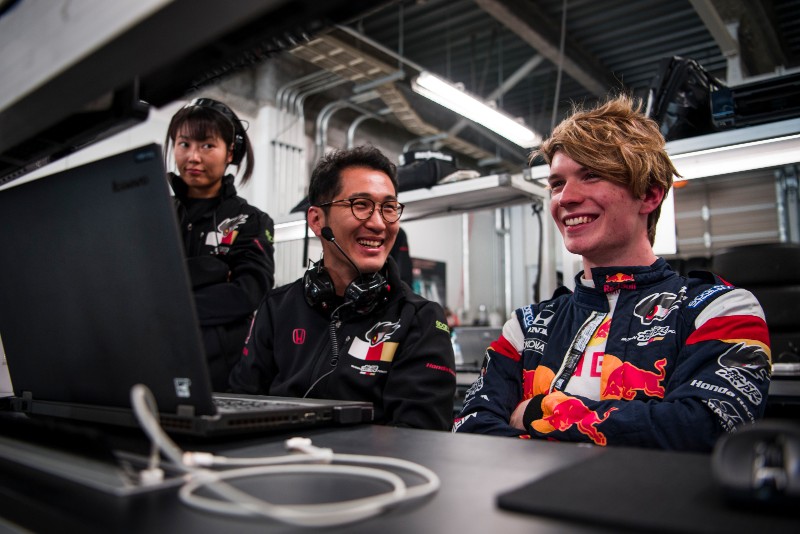
Photo: Red Bull Content Pool / Taku Nagami
Mick Schumacher?s late season European F3 dominance got into Ticktum?s mind last year, but one thing he does even more against his own advice is think too much about F1. Or as he once put it to Formula Scout: giving too much of his pie away.
In the second half of ’18, all the way through to after his second Macau Grand Prix win, it was still unclear where Ticktum would be driving next. Even after his SF seat with Team Mugen was confirmed in early December, the idea of being in the F1 paddock for select Formula 2 outings was still on the table.
SF?s new halo-equipped Dallara SF19 car is built to the same standards as F2?s latest machine, produces even greater levels of downforce and despite the use of grippy Yokohama tyres for flat-out racing is probably the closest thing to a modern-day F1 car. Early tests of the car which appeared gremlin free (something Marko looks out for), suggested it was on par with peak LMP1 machinery too.
This hasn?t been lost on Ticktum, who admitted that even its predecessor was better than the Dallara F2-2018, and considerably cheaper for the season.
The inclusion of a halo means the SF19 weighs roughly the same as a ’18 F1 car, and although a push-to-pass system exists, the car’s reliance on underbody downforce means racing should be close regardless. F2 proved a hit last year with its side-by-side action, and against a higher calibre of drivers it means the likes of Ticktum won?t have their FIA superlicence hopes dashed by points lost to crashes with more risk-prone rivals.
Ticktum crashed the preceding Dallara SF14 in post-season testing at Suzuka as he searched for the limit of Yokohama?s tyres. It?s a problem former F2 racer and Team LeMans signing Artem Markelov is also facing, having mastered Pirelli?s high degradation rubber, but Ticktum?s fellow European F3 graduate Alex Palou seems to be ahead of the curve at Nakajima Racing.
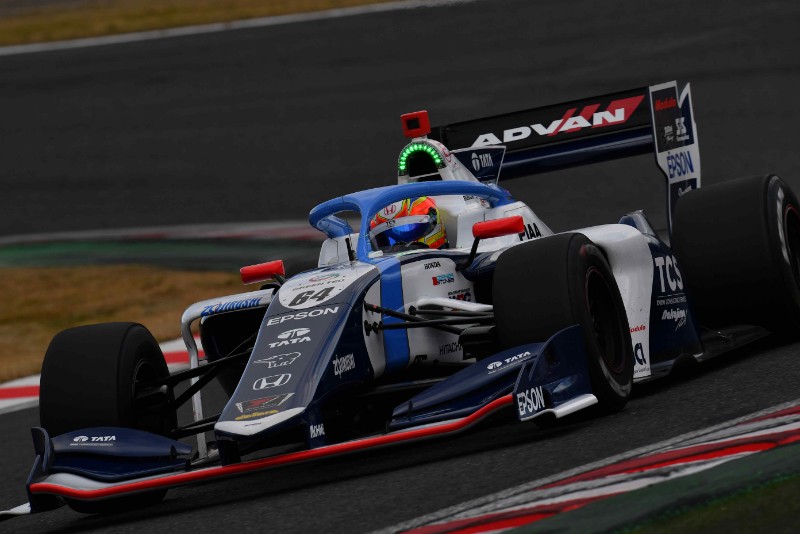
Photo: Super Formula
The Spaniard does have prior experience of Japanese F3 (more on that later), and throughout his career has always looked stronger on ‘harder’ compounds. His winning 2017 Formula V8 3.5 cameo on Michelins proved just that, as did breaking the Suzuka track record in the first pre-season Super Formula test. And unlike Ticktum and Markelov, he?s been teamed up with another rookie: F2 race-winner Tadasuke Makino.
Markelov is the only of the European converts to side with a Toyota-powered team, with Palou and Ticktum joining Honda juniors Makino and Nirei Fukuzumi in the opposition camp. Importantly for Ticktum, it?s Honda who Stoffel Vandoorne and Pierre Gasly impressed before racing in F1 with its power units.
Japan?s appeal has extended to teams too, with European F3 squad Motopark responding to its FIA F3 Championship snub by dominating the Macau GP and then linking up with B-Max Racing for a joint entry in Japan. Its SF line-up consists of Harrison Newey, who beat Schumacher Jr to the 2016-17 MRF Challenge title and is son of F1 design legend Adrian, and Red Bull?s latest junior Lucas Auer.
After starring in F3 in Germany and Europe, Mercedes-Benz signed Auer to its DTM programme for 2015. He won four races before the marque quit the series, leaving him without a drive. Then Red Bull came calling.
“It was a surprise to me, but I believe the timing of the talks was good,” Auer explains to Formula Scout.
“Me with having no contract [for 2019], and Red Bull and their Honda partnership I think was perfect timing to have another try at single-seaters. I told them: yes, I would love to do this challenge.
“Partnering up with Red Bull is for an Austrian, or for anybody, is something special. So for me it was a clear decision, although it [SF] will be difficult for sure. But I [really] want to do this.”
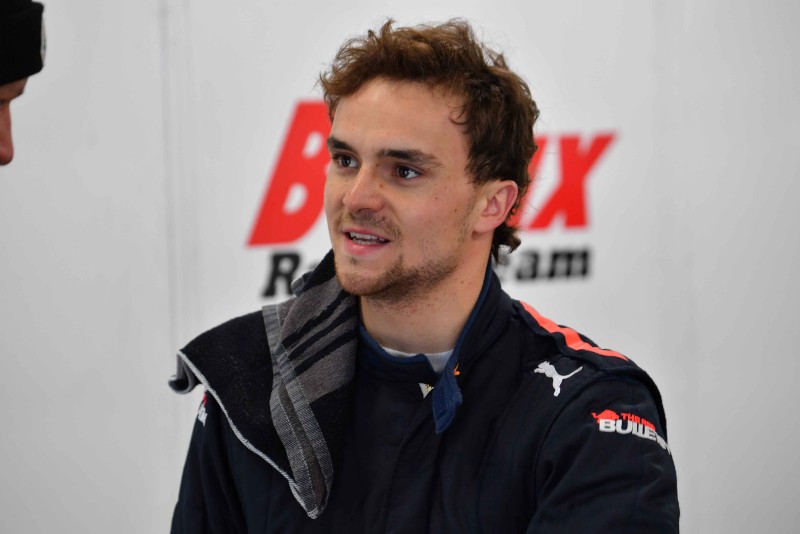
Photo: Super Formula
The 24-year-old’s Red Bull deal was announced in December, and Auer’s single-seater return was brought forward when he contested the Toyota Racing Series a few weeks later. He didn’t even have time to visit a simulator to prepare, flying straight from Japan to the first race in New Zealand.
While Auer was beaten by now Red Bull stablemate Liam Lawson in TRS, results weren’t the aim, and he was riddled early on with car issues. It’s a problem he may have to deal with again with a new collaboration in SF, and Auer is assured he has the professionalism that Red Bull and the series requires.
“[Adapting back] takes time. I learned some stuff in touring cars which is very useful, there’s some?stuff I need a bit of time on but at the end of the day it’s all manageable because the car has proper downforce and I just need to be open-minded.
“I’m a lot more experienced [than in 2014] and I should have a lot more mental and physical power, which should help over a season. In terms of pure pace, I?m not sure. For sure I saw and learned a lot more stuff so I should be overall a couple of steps higher.
“When I was in New Zealand [in 2012-’13 & ’19], it was bloody tough. There’s a couple of good guys from Europe, and then we have a couple of Kiwi guys. They’re normally proper fast because they know the tracks, they know everything, they’re at home, so at the end you have all these drivers that make your life bloody difficult.
“Of course that?s the best preparation. The more competitors, the higher the levels, the more you learn.
“We tested with the old Super Formula car [last December] in a rookie test. At first it was amazing, the car is so fast. It was incredible. But eventually you think: is there a lot of stuff to learn? Yes. A lot.
“Managing the new car will be bloody hard. And the Japanese drivers are flying. The levels here are proper high.”

Photo: Super Formula
The mental strength shouldn’t be ignored. Like in F1, SF is manufacturer versus manufacturer as well as team against team, and on a grid where talent speaks as much as money, you’ll inevitably lose your seat if there’s somebody better. On the other side of the coin, loyalty and results are thoroughly rewarded.
Auer could continue with Red Bull or engine supplier Honda for 2020 if he impresses, as there’s nothing in writing beyond ’19. If the inexperienced B-Max/Motopark team struggles, that’s by no means a reflection on Auer’s talent. As for Ticktum, he’s been placed in the team that ran Naoki Yakamoto to last year’s title, and knows he must finish top six in the standings to get the five superlicense points needed for F1.
Many have questioned Ticktum’s attitude in the past, but there’s undeniable dedication in carving out your career on the other side of the planet. There’s limited coverage in Europe, and a likely culture shock that could unbalance a driver as they try to embed themselves into very different surroundings. For proof of said phenomenon, look at the many Japanese drivers that have gone in the opposite direction, or the recent operational miscommunication between McLaren and Honda in F1.
Of course Ticktum has been placed in Japan by Marko, will still be UK-based due to his Red Bull simulator commitments, and will need to finish far higher than sixth to displace the current Toro Rosso line-up if they excel. His career is shepherded along by an F1 team, something those in SF’s feeder series do not enjoy.
Although grid size and quality perhaps don?t reach the peaks Europe has, anyone who heads to Japanese F3 will tell you it?s an almighty challenge.
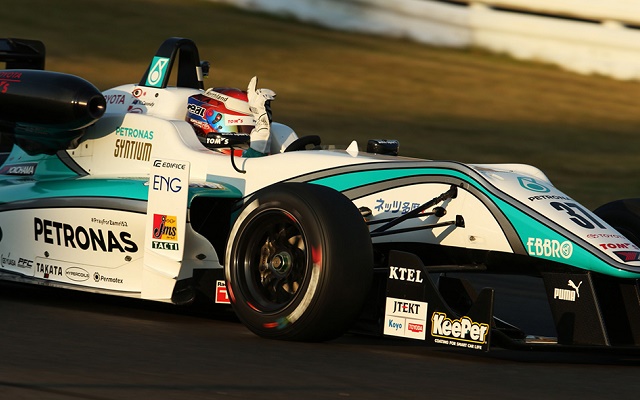
Photo: All-Japan Formula Three
Cassidy won the 2015 title before his brief full-time ride in Europe, and ?top foreigners? Jann Mardenborough and Palou were second and third in the ?16 and ?17 standings off the back of already successful junior single-seater careers.
Bar the Nissan-backed but relatively inexperienced Mardenborough, each driver has headed east of their own independence, and at least three rising talents have picked Japan over the European alternatives for ’19.
Carlin is following Motopark in entering Japanese F3, and is fielding Formula Renault Eurocup race-winner Charles Milesi. The entry is a collaboration with Okayama Team, which ran Yoshiaki Katayama last year.
Milesi’s name hovers under the radar in Europe, having won little on his way up the ladder, but his ability to come to terms with new machinery is proven and made his ’18 Eurocup season a success with his back-to-back wins at Silverstone and Monaco. Pre-season testing suggests he’s adapted to F3 already too, and the 18-year-old has even logged miles in SF machinery over the winter.
Motopark comes to the championship with Sacha Fenestraz and Enaam Ahmed, both of whom demonstrate two unique aspects of Japanese F3’s appeal.
After failing to find a drive in Europe, 2017 BRDC British F3 champion Ahmed won a shooutout test to drive for the Tomei-powered ThreeBond team, but ended up moving to Motopark after a sponsor issue meant he had to forfeit his original seat. Ahmed spoke to Formula Scout about his move Japan prior to switching teams.
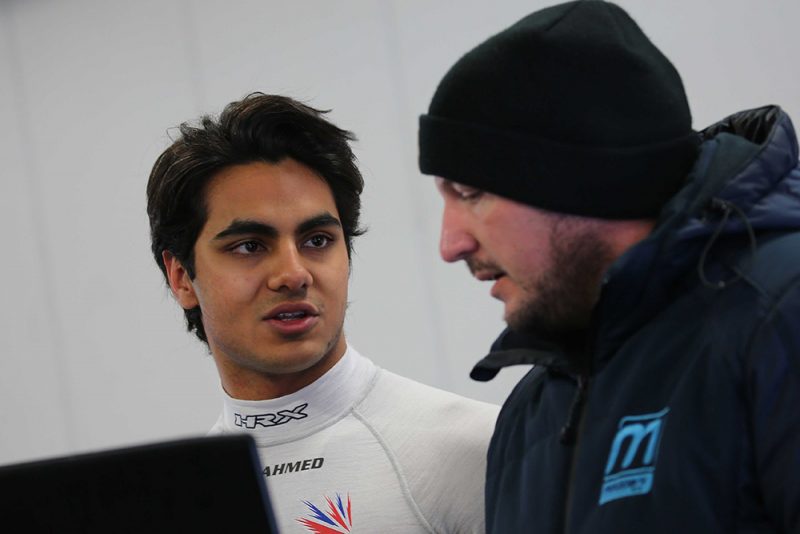
Photo: Japanese F3
“[The] car’s not very different in driving style, but you can attack on corners a lot more because the Yokohamas have a lot more grip than the Hankooks [used in European F3].?That was a bit difficult to get used to. It’s so much grip, so it’s really nice.
“Super Formula has got a lot of grip as well. I think this car teaches you how to use downforce really well.”
Driving for ThreeBond was a deal Ahmed “couldn’t refuse”, and with it being the only team running Tomei engines it would’ve technically made Ahmed a professional driver, with certain development responsibilities.
A ban on in-season testing means circuits and engine developments will be tried out for the first time in free practice, handing a considerable advantage to local drivers who have been racing in the same championship and circuits for several years.
ThreeBond had hired Ahmed because it thought he could better the locals though, but he should also be a title contender with his new team, as he points out: “Motopark were at their finest in F3 last year.”
The change of teams denies Ahmed the chance to replicate the previous heroics of ThreeBond drivers Alexander Sims and Cassidy. Both are now highly rated professionals, and relaunched their careers with top four finishes at Macau with the Japanese engine. Their reputations for brilliant technical feedback are no coincidence.

“I think it?s good that Sacha, Charles and I? have gone [to Japan]. It?s going to boost the championship?s profile a bit more,” reckons Ahmed.
“I?ve noticed that this season, not just in F3 but in Super Formula, Japan?s started to become a lot more popular again for European drivers, because there?s opportunity there.
“It’s starting a new life. I?ve raced in Europe my whole career, and now I?m going all the way to Japan to race cars. I?m looking forward to that. Not just in racing terms, but where my life can take me out there.”
Feeling similarly philosophical is Fenestraz, the ’17 Formula Renault Eurocup champion, and like Ahmed had a mixed year in European F3 last year. He ended 2018 being dropped as a Renault F1 junior, prompting him to look to Japan, and responded to Renault’s decision by finishing third at Macau. The two cars ahead of him were both run by Motopark.
Fenestraz is also making use of the fact that F3 often shares a bill with the other big Japanese series: Super GT. The likes of Cassidy and Naoki Yamamoto double up in SF and Super GT’s top GT500 class, and Yamamoto even won both for Honda last year.
GT500 now has a shared rulebook with the DTM, the home of the European F3 paddock for the last 15 years, and it seems remarkable nobody in Europe has simultaneously competed in both. The closest anyone came was Pascal Wehrlein, who dropped F3 after one round to forge a career in the DTM, F1 and then Formula E.
Reigning Japanese F3 champion Sho Tsuboi also starred in the secondary GT300 class last year, earning himself top seats in SF and Super GT’s GT500 class with Toyota. It’s a path Fenestraz is looking directly to follow.

“Coming to Japan [was always the plan], and when we knew Motopark was joining B-Max we were like: let’s do this. So we confirmed pretty early,” explains Fenestraz.
“The Super GT drive was a pretty late call. My manager got a call saying they were looking for a driver, we spoke a bit and decided to race that as well. It?will be the first time for me doing a double championship.”
Being able to race a variety of machinery at a professional level is standard for Japan’s best, and opens up doors further afield. Multi-faceted talents fill much of today’s IndyCar, FE and WEC grids, many of whom raced prior in Japan.
“I know Loic Duval and Benoit Treluyer pretty well. They raced in Japan for quite a long time, so they knew how everything was here. I asked for their opinions, what?s the best teams and that stuff.
“Having a roof on top of me is something completely new. I?m not alone [in the car] too. It?s a big car. Really massive compared to a formula car. You need to adapt quite a lot from a F3, in this case, but once you?ve done the first couple of tests and you?re used to it, then jumping from to another I don?t think will be a big issue.”

For a driver who admittedly struggled in his rookie F3 season, and expected his Renault dismissal, Fenestraz’s confidence ahead of the season is encouraging. He’s with Kondo Racing, which with Cassidy has recently become a benchmark squad, and he’s evidently very relaxed. Although Japan could open doors for him elsewhere, the aim is still F1.
“My goal is the same as since I was a kid: to get to F1. Coming to Japan is putting me a little bit out of that road, it?s just a little harder by coming to [F1] this way. But nothing is impossible.
“The plan is to jump to Super Formula next year with a dual programme in Super GT[500]. Then it depends on how things happen in SF. I think after Super Formula you are closer to F1 than doing a F2 season.
“Everything is going really well with Kondo. We?re still learning quite a lot, but I think we definitely have the speed to be battling in the top five, top three through the season. It?s going to be a tough but really nice season.”
Both Ahmed and Fenestraz cite recent dominator TOM’S as the team to beat in F3, with a line-up led by 2018 runner-up Ritomo Miyata. He’s another who’s learning, and probably eventually earning, in Super GT.
“Japan is an incredible experience, and the people here are really big fans of motorsport. At the moment I?m having by far the best year I?ve ever had in motorsport,” concludes Fenestraz.
